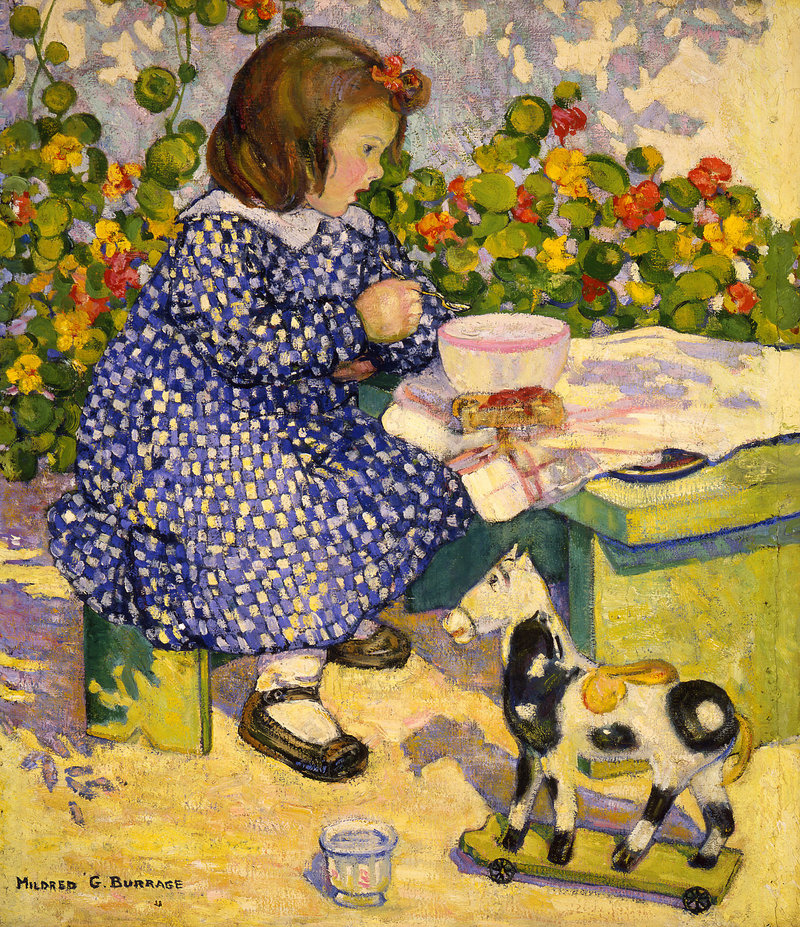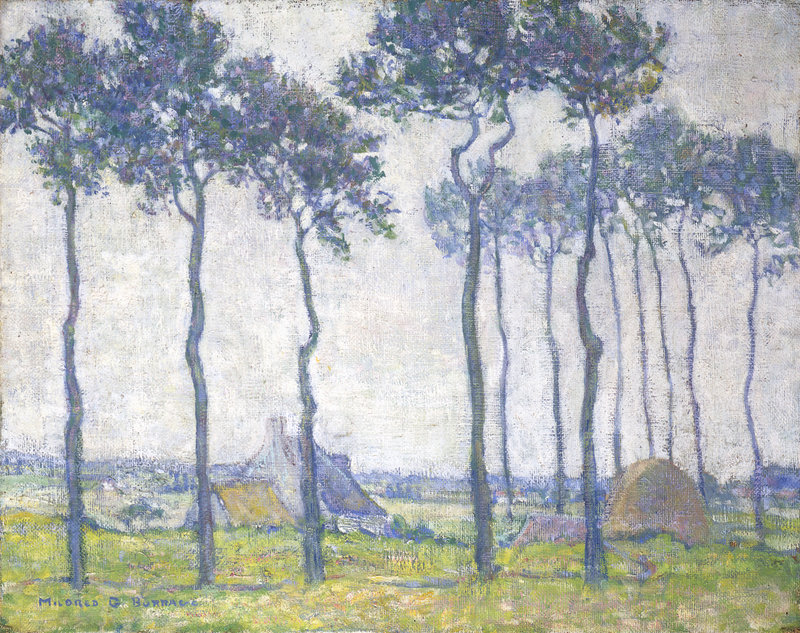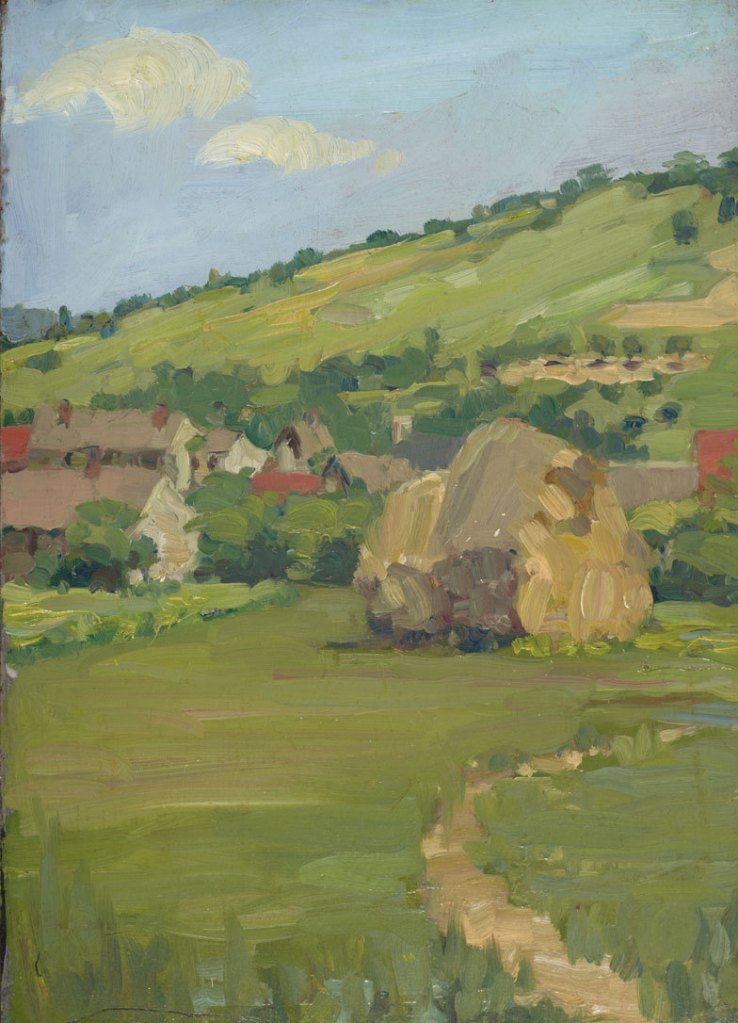The first, indirect description I heard of “From Portland to Paris: Mildred Burrage’s Years in France” at the Portland Museum of Art made me roll my eyes: “charming” American Impressionist paintings by a young Maine student studying in France.
But Burrage (1890-1983) was no typical student. She was extraordinarily bright and talented. And the story of her early studies in Europe — beautifully and cogently recounted in this show by Earle G. Shuttleworth Jr. — is fascinating and practically incredible.
After all, how many women from Maine lived and worked next door to Monet in Giverny, attended Gertrude Stein’s salon, showed at the Salon des Independents, won an award at the International Art Union, had a piece accepted into the 106th Annual Exhibition of the Pennsylvania Academy of Fine Art, and so on all by the ripe old age of 21.
It is extremely difficult for us now to see the radicalism of the changes in painting between 1880 and 1920. We understand that any American serious about art had to succeed on European terms, but the Modernist path was so triumphant that it erased its own tracks.
Watching a young artist try to incorporate lessons of the avant-garde while playing the part of a seriously dedicated student is fascinating. One of Burrage’s primary concerns was how to incorporate boldly simple strokes (like Monet’s) into an otherwise well-structured painting.
In a basic still-life with an orange and a blue pitcher, for example, she uses quite traditional chops to make something that looks like a Cezanne, except it’s painted in a traditional Dutch style. The fruit and table cloth are gorgeously handled, and the whole thing is punctuated with thick, white impasto reflections — more echoes of Rembrandt than French Modernism.
Sure, it’s a bit awkward, but I love this kind of painting, and it shows right away that Burrage could really handle a brush.
Burrage leaps to using the thick, finishing impasto to punctuate garden landscapes by rendering some flowers with fat strokes of paint up on the surface. While these, such as “The Garden” (the frontispiece in the handsome catalog), will no doubt garner the most “oohs” and “aahs,” they are my least favorite paintings in the show. Yet, they are extremely interesting and revealing works of art.
What is strange about “The Garden” is the relationship between the unmediated flowers in the foreground and the accomplished and sophisticated brushwork of the house behind them. A shadow cuts across the wall with a complex palette of warm colors above and cool colors below.
Trying to balance these two approaches to painting in a single picture is extraordinarily complex and difficult. What Burrage is doing — and why — is fascinating partly because it’s not always successful.
Burrage’s “November Day: Brittany” is a great painting. It follows the logic of Monet’s poplar series with its low horizon and slender trees snaking into the sky, but it has the coolly mystical cast of Symbolist painting and an apparent debt to Van Gogh in the organic rendering of a house and other elements in the landscape.
The surprising element is the reflected golden light on the ground and how this subtle temperature shift ironically splits the spatial earth from the cool abstracted trees and sky.
Probably the most popular piece in the show will be the “Souper a Deux” (“Supper for Two”), in which a young girl takes a light meal in the garden with her toy pull-horse. Sure, it’s a charming painting, but it’s no less complex than it is sweet with its mix of pattern, color, light, flatness, spatial modulations, color-rich shadows and situational narrative.
A 1914 Venetian scene is another masterwork with similar concerns. While the old world basilica of Santa Maria della Salute is handled with finely textured and light-sculpted solidity, the foreground boats boast the brash color of Fauvism. And it works.
Because Burrage had a long and ever-changing career as an artist, it was very smart for the PMA to show this chapter separately. The context effect is fantastic, with several works by her friends and teachers (the landscape Burrage bought from her teacher Richard Miller is terrific) as well as works by Monet, Cassatt, Renoir and others in the next room.
As well, Burrage’s illustrated letters are effervescently energetic, and her drawings are some of the most interesting work in the show.
While I particularly like some of her sketchier paintings such as her “Left Bank, Paris” and the PMA’s squishy delicious “Giverny,” her drawings can be amazing. A piercing self-portrait will no doubt be a crowd favorite, but I am in love with her sketch of a woman’s chignon, and possibly the most interesting work in the show is a very strong-standing nude woman — a respectable young woman; after all, drawing the nude in 1910 still raised questions.
This is a well-researched and, ultimately, very impressive show.
Freelance writer Daniel Kany is an art historian who lives in Cumberland. He can be contacted at:
dankany@gmail.com
Send questions/comments to the editors.




